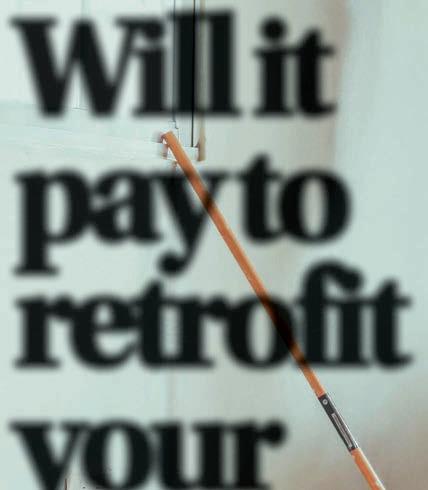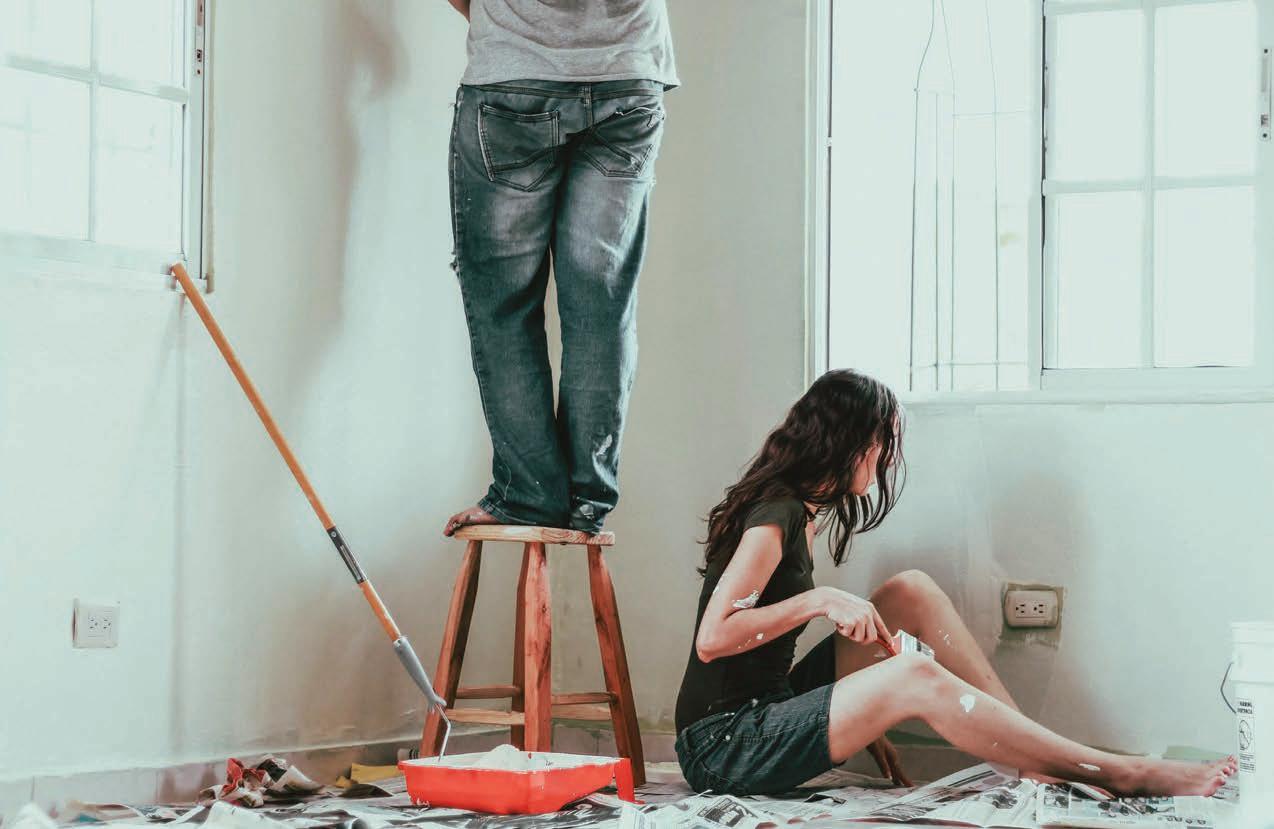
20 minute read
Marianne Heron
As I See It

Advertisement
Marianne Heron Our sins of failure as testimonies shelved again

is week the lurch of combined anger and incredulity I felt over the Commission Report on Mother & Baby Homes ignited again. I was dismayed by the 2021 report which was criticised for its inadequacies, including the failure to report hundreds of testimonies given by survivors. Following public outcry, a review of the testimonies was promised. is has now been shelved by Minister for Children Roderic O’Gorman in favour of an alternative ‘initiative’ without consultation with those representing survivors. e su ering and institutional mistreatment of women and children has been discounted yet again and decisions about them once more taken, over their heads and behind closed doors.
“We are being eradicated from history,” says Clodagh Malone, Chair of the Coalition of Mother &Baby Home Survivors (CMABS), who was born in the St Patrick’s Mother 7 Baby Home, 0n Dublin’s Navan Road. “We are not surprised that we are at the bottom of the pile compared with the Magdalene laundries and the industrial schools.” e three-member commission was set up in 2015 to examine practices in Mother & Baby Homes between 1922 and 1998 following the discovery of 800 bodies of children in unmarked graves at the Bon Secours Mother & Baby Home in Tuam, Co Galway. e report found that around 9,000 children (one in every seven. that is twice the national infant mortality) had died in the 18 institutions included in the investigation and the report also con rmed that children had been used for medical experiments.
But it failed to deal with issues such as forced adoption, forced labour and involuntary detention as well as excluding and misreporting testimonies of hundreds of survivors.
Minister O’Gorman’s ‘initiative’ would encourage survivors to tell their stories afresh or to have their original testimonies used for inclusion in records at a National Centre for Research and Remembrance in a future site at a former home in Sean MacDermott Street, Dublin is initiative will take years to complete. Meantime, more and more of the elderly surviving mothers will die before justice is done.
“ ey should have got it right the rst time; the Commission didn’t tell the truth,” says Clodagh Malone. “What people want now is a proper apology and redress. A lot of survivors were retraumatised after giving testimonies’ this is a community of extremely vulnerable people. ese women just want a few bob to bury themselves.” e ndings of the commission were also criticised by outgoing children’s rapporteur Professor Conor O’Mahoney in his annual report. His views, made independently of the Ministry for Children, dealt with human rights issues, and said the commission had downplayed the question of forced labour whereas he had found quite a signi cant level of forced labour.
He also disagreed with the commission’s view that the women were not incarcerated in the homes and found that the de nition of the deprivation of liberty was met in quite a number of cases in the homes.
Meanwhile, CMABS want to see a lifting of the rule on the Government’s proposals for redress, which excludes children who were in mother & baby homes for less than six months. “We want to have equality among survivors. Many of them feel guilty that others are being treated di erently,” says Ms Malone.
One of the ongoing sources of distress for survivors has been the di culty or denial in accessing birth and early life records. e story of a mother’s search for her son was poignantly portrayed in the 2013 lm Philomena with Judi Dench and Steve Coogan. From October, the Birth and Information and Tracing Act will give survivors a right to their information and establish a contact register.
Clodagh Malone runs a ‘search angel’ to locate birth certi cates for survivors seeking redress. But she caytions survivors nding out about their origins: ”It may be the toughest day of their lives.” Records, she says, may sometimes reveal instances of pregnancies resulting from rape, incest or clerical abuse.
We should know more about how the rest of those stories went. e commission heard testimonies from several hundred survivors, a tiny fraction of the estimated 75,000 women and the 66,000 of the children who survived, who were in homes until they closed in 1998. ose women and their children were the victims of the punitive attitudes which prevailed against unmarried mothers at the time. ey were failed by families, partners, Church and State in a way which today is seen as a shameful chapter in our history. We shouldn’t fail them again by shelving the truth of their stories.

Terranova launches a new collagen alternative- Vollagen®
CLAIR WHITTY
Vollagen®, what’s it all about? If you’re interested in collagen but you are vegan, or you just can’t stomach the idea of taking a bovine or a marine sourced collagen supplement, then I have some exciting news for you. Terranova one of our favourite brands has launched Vollagen®, a range of supplements which are an alternative to collagen, with all the bene ts of collagen and more!
What is Vollagen®? Where does it come from? Is it as good as animal sourced collagen? I didn’t know the answers, so I asked Laura. Laura is a Nutritional erapist who works with Terranova. “Vollagen® is from bacterial fermentation and provides the building blocks (amino acids) for all human collagen types. ere are 28 types of collagen, di erentiated by the location in the body where they are formed and used. Regardless of the ‘type’, the amino acids are the exact same. Supplementing with Vollagen® allows the body to use these building blocks in the most appropriate way depending on individual needs of each person. e beauty of Vollagen® is that it’s also suitable for vegans, vegetarians and available in capsules. You don’t need to worry about animal origin or hydrolysis.”
Collagen is the most abundant protein found in the body where its key role is to manufacture connective tissue, a major component of skin, hair, bones, tendons, ligaments, muscles, and cartilage where is helps to make tissues strong, resilient, and capable of withstanding stretching. It’s also found in gut tissue. Research has shown collagen may be bene cial for those who su er with gut disease restoring the integrity of damaged gut lining. e ageing process results in a reduction of collagen production but other factors such as excess sun, free radical exposure, poor diet and inactivity also speed up of collagen degradation. Collagen supplementation has become a popular way to provide the raw materials needed to maintain and enhance this connective tissue within the body. However true collagen is always derived from animal source. is new Vollagen range is totally vegan. Several products are coming on stream over the next short while, products will include Vollagen® Complex, Vollagen® & Hyaluronic Acid and Vollagen® & Glucosamine.
For more information check out our in-store information days, plus there’s 25% o the whole Terranova range for September.
Shop in store or online at www.naturalhealthstore.ie where you’ll be able to take a look at these supplements.
Shop online@naturalhealthstore.ie Natural Health Store, Market Cross Shopping Centre Phone: 056 7764538 Email: info@naturalhealthstore.ie

The sea...
Reader, the following tale/drama was passed on to me in dribs and drabs, all, naturally, from ‘the old days.’ ere will be some subsequent chapters, each one more or less a story on its own – but linked as well. I can only give facts as well as I can assemble them. Truth there is in fair supply – but even Shakespeare had to invent the odd scenario in order to stitch in missing patches, to create a pattern. Anyway – as that incomparable wordsmith declaimed – “ e Tale’s the ing!” And remember – I, Ned,am narrating and acting the part of Jonathon Conway, who is no longer about…
e Tale….
It was 1940, wartime, and I, J Conway was on a special mission to the USA. Based in England, I and my new wife Marie took the opportunity to visit our old haunts in Kilkenny Town, on our way to Waterford, then to Cobh. So, we headed down to Waterford, and booked into a small hotel on the Quay. Honeymoon nights were still upon us, and, listening to the midnight River Suir slapping around the bridge in gusty September storms of rain, we were ful lling our Biblical obligations by getting down to that natural friendly business that is traditional with all newly married couples. We had, after all, been enjoined by the Big Man in the sky to ‘go forth and multiply.’ In this cultural and religious obligatory task, we soldiered on manfully – and womanfully…
We were, of course, conscious of the daintilyprowling activities of the virtuous-seeming old hotel manageress, but didn’t pay too much attention to her quiet footfalls. Although the marriage bed was of the well-strung instrumental genre – and therefore wont to play sweet music as an accompaniment to whatever joyous love-song was currently being performed by moonstruck man and magical macushla. Which e orts varied in cadence and rhythm between Ravel’s frenetic ‘Toccata’ - and the dreamy ‘Blue Danube.’ Just before drifting o to well-earned sleep, trembling on the peaceful velvety air, came a sweet rendition – in a small faded contralto – of “She’s only a Bird in a Gilded Cage” – right outside our door! We smiled as Morpheus swept us away to his world of dreams…
At the breakfast, our dear ancient hostess was gracious and kind, and enquired sweetly - if ‘we’d slept well’ – with an innocent smile that disarmed that stealthy old question! She then surprised us by disclosing her own tale of old romance. “A, sure my own luck ran out before I could know the delights of marriage and love,” she said, wistfully. “I had a fellow, Nathanial Storm, a ne young man, who went to Australia to make his fortune. I got four letters, then silence. His talk was mainly about missing Ireland, and me. His sister called to me a few months after the last letter, in 1901. We were all close – his whole family really wanted me to join them. ere was something intellectual and aristocratic about the Storm clan – there were ‘big people’ in their lineage, way back. She, Violet, told me Nathanial had gone into the West Australian Bush looking for gold, and never came back. I didn’t know what she meant - didn’t know that gold grew on the bushes down that way. He, or even bits of him - were never to be found, anyway...
“I hope you didn’t mind me singing that little song outside your door – you probably thought ‘crazy old woman!’” We assured her, and it was true - that we were delighted - not at all o ended. is pleased her. “I do it sometimes” she went on “to bring young couples luck – especially those who appear nice and really in love with each other. e ‘Bird in the Gilded Cage’ wasn’t meant for you, Marie – that was me – all these years waiting, hoping Nathanial would come back, squashing any feelings I might have had for other men, keeping myself pure for him.
“ at was the way we were, the way life was, in those days. I couldn’t betray him. Even if I’d been told that some wanderer came on his sad lonely bones, I’d not have wed another. We’ll meet in Paradise, Nathanial and me. Maybe God can arrange some tiny corner in a Garden of Eden for us to honeymoon in! I know that’s sacrilege, but I’m sure the ‘Great Man’ would forgive an ancient woman these strange old thoughts… I doubt I could nd Nathanial amongst the crowds Up ere ere, though.
“I pray every day that we’ll meet again. I hope you don’t mind me talking like this. To tell the truth, I seldom mention Nathanial. Everyone thinks I’m just an old maid, but; strange as it may seem, I’ve had a deeper love than most, in that my man has never disappointed me, nor I him.”
It was a great little story; I told her I was a writer, and would like to publish her tale of faithful love, and cruel loss. At this she gave a little cry of astonishment: “A writer? at’s amazing! I don’t know what to say!” I hastily assured her I wasn’t anywhere near the high league inhabited by Tolstoy or Sir Walter Scott – but merely a paid scribbler for an English paper. “Never mind that” she said, in a rush – “Nathanial left me a bundle of diaries and notes that came down through his antecedents, and nished up with him. He said in his very last letter that if anything happened to him – I was to ‘get some writer to put the whole lot together into a story. at’s what amazed me, Jonathon. Apparently there was a beautiful and very clever girl, way back a century ago, who came into Nathanial’s ancestry in some unusual and spectacular way. I don’t know if it turned into an ‘event’ or what, but it was a strange and odd episode – without being harmful or dangerous to anyone.
“Violet knew bits about it – and said ‘go ahead with whatever Nat wished – old a airs mean nothing these days – and if it is what he wanted – that’s good enough for all of us.’
“So there you are, Jonathon. I know you’re away tomorrow to America – you’ll catch the boat – but it looks like I’ve missed another, in this life. If you ever come back, the bundle is in the bank safety deposit box. I wouldn’t want a re or a ood to destroy it. But it doesn’t leave the County, ever. So, if you return, the two of you call in, and I’ll place the whole lot in your hands. If I’m not around by then, I’ll leave them to you in my will. ey’ll be in the bank just below, on the next corner.”
Well, I was dumbstruck. Here was a chance for me to write and publish a story of huge interest – and here was I – going thousands of miles away! What to do? What on earth to do?
So, we say our goodbye’s - Hanora didn’t want to take the money for the night, but we insisted - and headed o to Cork, and Cobh, to catch this old rust bucket.
“We’re going to sea in a sieve, a sieve!” we sang, reclining in our Spartan cabin – with reasonably high hopes of making it to New York – enemy explosive ordnance permitting. Heaven - or Hell - were the alternatives. Wallowing along at about eighteen knots – the subs, incidentally, could do twenty – we watched the great rollers of the Atlantic cruise by in stately shapely, mountains - and hoped that each and every Fritzie Germanicus was o on holiday – killing time in some barracks – or o killing somebody else. It was that time of the year, when the moon was as big as a house, and the reclusive fellow who dwelt there had a face as yellow as a giant primrose.
Ned E.

As the Government announces its plans to retro t 500,000 homes before 2030 to reduce energy consumption and make homes warmer and cosier, one wonders why it has taken so long. at said, and with the growing energy crisis, deciding to retro t the house you have been living in for years is no easy task – even with the increased Sustainable Energy Authority of Ireland (SEAI) grants helping to cushion the cost.
First, you must decide whether you can a ord both the nancial outlay and the domestic upheaval of a deep retro t (which includes everything from attic and wall insulation, new windows and doors, conversion of heating system from gas/oil to a heat pump, advanced ventilation and photovoltaic (PV) solar panels for electricity generation).
And if a deep retro t seems too daunting, homeowners can instead take a step-by-step approach to retro tting by doing attic and cavity wall insulation one year, putting in new windows and doors another year and later embarking on transforming their heating system from oil/gas to an air-to-water heat pump system.
Solar PV panels are another option for those who want to generate their own electricity. And there are new SEAI grants available for many of these oneo measures too.
“ e one-stop [retro tting] shops o er homeowners guidance from start to nish, which includes the design stage, choosing and managing the contractors, applying for the SEAI grants and completing the BER at the end,” says Brian O’Mahony, head of retro t and communities at the SEAI. e newly announced SEAI grants cover up to €25,000 of the costs for a deep retro t which brings your home up to a B2 rating. An additional grant of €2,000 is available for those who install a heat pump as part of their retro t. And, energy suppliers also o er their customers so-called carbon credits of about €2,000 when work is carried out by a partner company. e estimated cost of a deep retro t for a three-bedroom home is between €60,000 and €70,000. e SEAI grants must be drawn down within a 12-month period from when work starts and if you work with a retro tting company, the discounts will be deducted at the start of the job.
But for those who don’t have the funds (or don’t want to take out a loan) to embark on a deep retro t, it’s also possible to take a step-by-step approach to retro tting your home.
“Some people know exactly what they want to do and can manage the grants themselves so the step-by-step approach suits them,” says Mr O’Mahony. e SEAI grants on single measures are paid when the work is completed.
Rory Clarke from House2Home Retro ts (which partners with Energia) and Peter Campbell from Energlaze (which partners with Bord Gáis) agree that when it comes to deciding which retro tting jobs to begin with that it’s “fabric rst”. In other words, you start by insulating your attic and walls before you move on to installing new windows and doors and then, upgrading your heating system from oil/gas to air-towater heat pump is the nal job.
Owners of period homes should seek advice from retro tting specialists who have experience and knowledge of the breathable insulation required for homes built in the 17th, 18th and 19th century. “Period homeowners can put in attic insulation, new windows, improve their heating systems and generate electricity on site, but breathable insulation must be used for these homes. Most homes built after 1900 can take the modern insulation materials,” says O’Mahony. is year sees about 20 socalled one-stop shops registered with, and audited by, SEAI to help householders embark on deep retro ts on their homes.
Mr O’Mahony says that seven or eight of these companies will operate throughout the country, while others will work with homeowners in speci c regions or counties. Many of these retro tting businesses team up with energy suppliers who incentivise their customers to retro t their homes by o ering them so-called carbon credits worth about €2,000.
“Most of these companies will already have experience in retro tting but it’s a good idea to shop around and talk to one or two companies, get references from homeowners who used them and talk to people who’ve already done it,” says Mr O’Mahony, who estimates that most deep retro ts can be completed in ve to six months. e rst step on your retro t journey is to have an energy assessment on your home. is assessment, which costs between €400-€700 (€350 covered by an SEAI grant) is carried out by an independent assessor. It includes a full technical assessment of the fabric of the house as well as tests for air tightness and heat loss. An assessment of the current BER rating and what measures will be required to bring the home to a BER of B2 is also included. e homeowner can then decide whether to use the service of the retro tting contractor who organised the home energy assessment or bring this assessment to another retro tting contractor instead.
Opting to put in solar PV panels on the roof of your house and/or garage is a personal choice. “Some people will go with solar and some won’t. Getting a BER of B2 isn’t dependent on them but some people will want to generate electricity and particularly when the feed-in tari comes in,” says Mr Campbell.
New low-cost loans are expected to become available later this year through banks, credit unions and post o ces for people retro tting their homes. e retro tting companies will have these details once the Government sets the low interest rates with the Strategic Banking Corporation of Ireland.
Homeowners who qualify for the SEAI Warmer Homes schemes can apply for fully funded deep retro ts on their homes. Eligibility requirements include those on job seeker’s allowance, disability allowance and working/one-parent family payments. e recently announced scheme will prioritise homes built before 1993 with a BER of E, F or G. e one-stop shops are available to people who own homes built before 2011 with a BER of B3 or lower.

SPECIAL REPORT Will it pay to retrofit your house?

What does such work involve?
e Sustainable Energy Authority of Ireland (SEAI) is Ireland’s national energy authority, investing in and delivering appropriate, e ective and sustainable solutions to help Ireland’s transition to a clean energy future.
SEAI works with citizens, communities, business and Government to help achieve Ireland’s clean energy transition. As part of its role, SEAI helps thousands of homeowners each year to make their homes more comfortable and energy e cient, while also reducing their energy bills. is ranges from free energy upgrades if you are in receipt of certain social welfare allowances, to varying levels of grant support depending on the scope of the energy upgrade. You can get grants to do individual energy upgrades such as insulation grants or heating systems grants, or you may choose to undergo a deep retro t all at once. While this is a big undertaking, higher grant support exists for deep retro t to help you achieve a really energy e cient A-rated home. e Deep Retro t of a home means carrying out multiple energy upgrades all at once to achieve a BER of A-rating. • Firstly, you will need to reduce the level of heat loss so that you keep heat in the home for longer. is involves some or all of the following: wall insulation, roof insulation, oor insulation, window upgrades. • e next step is to look at an e cient renewable heating system to support the transition away from fossil fuels. e typical heating system installed on a Deep Retro t Pilot Project is an air-source heat pump. • It also includes mechanical ventilation to maintain good indoor air quality. • Other renewable energy technologies such as solar water heating panels and solar photovoltaic panels may be appropriate for your home.









